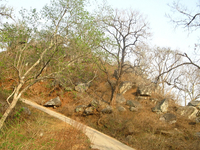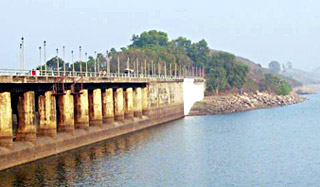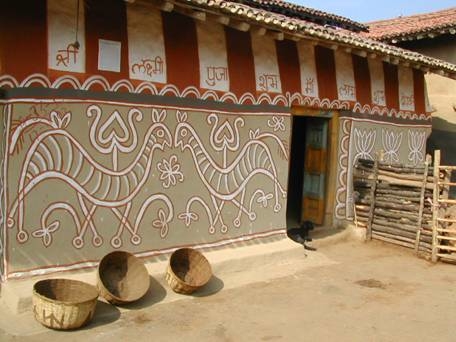The district of Hazaribagh is situated in the north east part of North Chotanagpur Division in the state of Jharkhand.. The boundary of this district consists of districts of Gaya and Koderma in the north, Giridih and Bokaro in the east, Ranchi in the south and Palamu and Chatra in the west.The word Hazaribagh comes from two words - ‘Hazar’ and ‘bagira’. ‘Hazar’ literally translates to ‘1000’ while ‘bagira’ translates to ‘cat’. Therefore, the literal meaning of the name of the city is the ‘city of 1000 cats’. Hazaribagh was a cantonment from 1790 to 1884. Hazaribagh flourished under the British Rule and what resulted was a planned city. Today, that part of Hazaribagh is the Boddam Bazaar. Boddam Bazaar is named after the officer by whom it was planned. Coal reserves form the major chunk of revenue for this city. In fact, Hazaribagh has the second highest coal reserves in the state of Jharkhand.
How to reach here:
By Air: Nearest airbase is at Ranchi which is well connected from major cities in the country.
By Rail: There is no railway station in Hazaribagh. The nearest rail heads are at Koderma and Ranchi, which are well connected from all over the country.
Best time to visit: October to March.
Languages spoken: Hindi.
Places you must visit:
Canary Hill has a well-laid out park and is studded with three small lakes. It has an observation tower. From the top of the hill one can have a panoramic view of the town. Perhaps the best place to soak in Hazaribagh's natural beauty is from Canary Hill, which affords not only a bird's eye view of the town and the lakes but also the dense foliage that surrounds it.

The Hazaribagh National Park is one of the most renowned Wildlife Sanctuaries in India, standing on a stretch of 184 sq. km midst meadows and dense tropical forests. The sanctuary has a long road about 111 km that takes to the remote ends of this sanctuary and to the masonry towers from which spotting the animals is easier. Kakar sambhar, cheetal, nilgai and wild boar are some of the animals that can be spotted easily around the waterholes during the dusk, while the tigers might be a little elusive to find. This park is around 135 km from the city of Ranchi and has facilities of a canteen. The sanctuary also provides a glimpse of the surrounding tribal life that resides close to the sanctuary. As a part of the entire trip, tourists can also go to places Tilaiya Dam and Salparni.


Rajrappa is an important pilgrimage site of the Hazaribagh District and is situated at the confluence of rivers Damodar and Bhera. This place has a famous temple dedicated to Goddess Chhinnamastka and has idols of Maa Kali, Lord Hanuman and Ashtdhari.


Suraj Kund is a major tourist attraction given its unique distinction of being the 'hottest' hot water spring in India. The spring's waters which have curative properties are always at a temperature of 87 degrees celsius.

Hazaribagh Lake is surrounded by AIR station or Urban Haat on the north, Ranchi – Patna Road on the east, the main town of Hazaribagh on the south and the renowned Indira Gandhi Balika Vidyalaya on the west. There are four distinct parts into which the lake is divided.The best view of the sunrise and the sunset is enjoyed at the end of the third lake, which happens to be the largest one. This is the ideal place for photographers. One can also visit the Swarna Jayanti Cafeteria, which is the only eatery in this region. This cafeteria has a garden in which to provide fun to the tourists has the service of a toy train.

Barso Pani is popular for the semi-formed cave, with which a myth is associated that states, when one claps or shouts “Barso Pani”, the cave starts raining. However, in reality the ceiling of this structure sheds water drops giving an impression of rain and it does so without anyone calling for it. Interestingly, it is only the centre of the ceiling from where the rain drops fall, and both the sides remain dry.Although there is a small river close to the cave structure, but it can’t be considered the source of these drops of rain. Trekking enthusiasts can trek for roughly a kilometer from Jhikjhor to reach the natural surroundings of Barso Pani.

Konar Dam is located at Banaso at a distance of 50 km from Hazaribagh on the Vishnugarh – Bokaro Main Road.The Konar Dam is a huge reservoir constructed on the River Konar that provides great views of the surrounding landscape.

The Tilaiya Dam is a project of the DVC that is located on the borders of the districts of Koderma and Hazaribagh. The dam is actually located in Koderma, but the views and landscapes around the reservoir are enjoyed from Hazaribagh.Tilaiya Dam is as a major producer of hydro-electricity for the district. It is situated on the Ranchi - Patna road that extends to GT Road.

The Bhadrakali Temple is located about 60 km from the district headquarters. This temple is about 400 years old and houses the statue of Bhadrakali. It is located at the confluence of River Mahane and River Vaksha.

The Narsigsthan Temple is dedicated to Narsingh, an incarnation of Lord Vishnu. The temple is located about 6 km away from Hazaribagh, in the village of Khapriama. There is an idol of Lord Vishnu and a Shivalingam.Located near the Narsigsthan Temple are a few more temples that are dedicated to Kali, Surya Dev and Dasawatar. A grand fair is organised on the day of Kartik Purnima.

At Pankuri Barwadih are the megaliths or huge stone observatory used for astronomical purposes. There is a group of megaliths found close to Barkagaon that is about 25 km from the headquarters of the district. The megaliths are arranged in such a manner that two of the most distinguished megaliths create the alignment for the formation of an Equinox point.On every 21st March and 23rd September, many villagers, tourists and researchers visit this place to observe the Equinoxes. The observation takes place for 30 minutes. It is also known to offer great views of the sunrise and sunset throughout the annual Solstices. The scientists and researchers, who study the movements of the Sun, verify with these megaliths, as observatories from the prehistoric time



Painted Houses of Hazaribagh :The two art forms practiced in Hazaribagh are the Sohraj and Khovar, which cannot be easily spotted in the main town, but can be seen in certain villages like Bhelwara. The art form Sohraj, being practised throughout the harvest season uses various imagery of wildlife and nature. With industrialization and modernisation, this form is getting restricted only to paintings which are done on some houses and on hand-made papers to keep the form alive. These are exhibited and sold at the Jharcraft emporium in the Urban Haat of Hazaribagh. Some specimens of such art forms can be seen in the Sanskriti Museum and Art Gallery.The colorful paintings of Sohraj style involves the use of natural pigments that are mixed with mud as colors, water to lighten it and a stick of a tree to mix the color which is generally used to brush the teeth. There are stylistic similarities between the styles of Sohraj and rock arts of Isco. On the other hand, Khovar comes from two words, namely ‘Koh” or “Kho” that means cave like structure and “var” that means husband. This art form is basically practiced in the marriage season and the houses are painted to identify the bonding.



Sanskrit Museum and Art Gallery is located in Dipugarh, which is a part of the main town only. This museum focuses on displaying and highlighting art forms traditionally recognised in the various districts of Jharkhand.There are various paintings of Kohvar and Sohraj exhibiting different styles being displayed here. Even the walls of the nearby houses are also painted. The interior of this museum-cum-gallery has been designed imitating the cave paintings of Isco.



Isco Rock Art : The Isco village is located within the Panchayat of Napo, at a distance of about 45 km from the town of Hazaribagh.This village is renowned for Cave and Rock Paintings of Isco dating back to 10,000 BC to 4,000 BC. This site is very popular for its depiction of artistic, historical and cultural background of ancient settlements.In the southwest direction of the Marwateri cave at a kilometre distance is the popular Isco rock paintings that came into the limelight only in 1991. The rock is above 100 ft high and is divided into 4 distinct sections that are interconnected to form the hook of a cobra and hence the local Oraon and Munda tribals call it Kohbara. These tribes stay in mud houses within a few 100 yards of this rock. This Kohbara, made of sandstone is positioned in such a way that it divides the village from the jungle.This rock has been dated to the Meso-Chalcolithic period, which is somewhere between 7, 000 BC and 4, 000 BC, in the appearance of copper and microliths technology. Here, Vindhyan type microliths or surgical microliths are found in huge numbers, which includes core stones, hammer stones, Neolithic Celt and many more.This had been the site of copper smelting and huge copper mines can be found even today, where the production of copper figurines of the Malar tribe can be seen. This tradition of copper figurines and their holy illustrations can be seen which extend from the Hazaibagh Plateau to Damodar Valley and also to the hilly regions of Bastar in the state of Chhattisgarh.Isco Rock Art is considered an example of the prehistoric skills of the rock artisans in India. Here bifacial and single choppers, pebble choppers, hand axes and some fake tools have also been discovered.This rock painting tradition has been taken up by the Ganju and Kurmi tribes of this area, who inhabit in this area and paint their houses traditionally. The motifs seen in Isco are rhinoceros that has been extinct for 200 years in this area, human figures, bull and wild cattle, mandalas, cryptic writings and pictograms that are un-deciphered, sun, rainbow serpent, yoni, concentric circles, and other patterns and designs.





Kandaver Temple is located adjacent to Barkagaon – Keredari Road that is presided by Goddess Siddhidatri or Ashtabhuji Durga. This temple is situated in a forest cover and is placed in remote location, making the place quite silent. The idol of this temple is believed to have appeared on its own many years ago.

Very nice information on Hazaribagh, its very beautiful city. Many people from all over Indian come to enjoy and relax. The distance between Hazaribagh to deoghar is 179 km only.
ReplyDeleteWelcome to Stoneberry Resort, where every moment is a treasure. Our resort is nestled in the serene beauty of Madhupur, offering a perfect blend of comfort, luxury, and nature. We provide you with an unforgettable retreat, where the hustle of everyday life melts away. From the moment you arrive, you will be embraced by our warm hospitality and the stunning natural surroundings. Our well-appointed accommodations offer the utmost relaxation, featuring modern amenities and breathtaking views. Our on-site dining options offer a delightful culinary journey, showcasing local flavors and international favorites.
ReplyDeleteExploring Madhupur, Jharkhand:
Deoghar: A short drive from Madhupur, this town is a renowned pilgrimage destination, famous for the Baidyanath Temple.
Jai Baba Basukinath Temple: This revered temple is one of the most important pilgrimage sites in the region, dedicated to Lord Shiva.
Madhupur Dam: A key water reservoir on the Barakar River, an ideal spot for picnics.
Usri Falls: A hidden gem in Jharkhand, this captivating natural attraction is located in the Giridih district.
We are also glad to offer an in-house catering service, ensuring a seamless and delightful experience for your event. Our expert culinary team prepares delicious, customized menus, ensuring every dish is crafted with care and attention to detail. Let us make your special occasion unforgettable!
Your Dream Wedding, Made Simple and Affordable
Stoneberry Resort is a wonderful location for your dream wedding. We understand that while weddings are a beautiful celebration, they can be challenging to prepare for, especially with budget restrictions. Our resort in Jharkhand is an excellent choice for an affordable destination wedding.
Why Choose Stoneberry Resort?
Low-Cost Bundles: We recognize how important it is to keep expenses down when celebrating love. Our customizable wedding packages are inexpensive for a variety of budgets, making it easy for couples to create their dream wedding.
Exquisite Accommodations at Reasonable Rates: Make your visitors feel at ease without going over budget. Our resort offers elegant but fairly priced rooms, offering a pleasant stay for all guests.
A Beautiful Setting for a Reasonable Price: Stoneberry Resort, nestled in the calm splendor of Jharkhand, is the ideal wedding venue, with gorgeous event venues and breathtaking vistas. At a modest price, you can have amazing beauty.
Affordable All-Inclusive Services: Our all-inclusive packages, which include catering and décor, will save you both time and money. Our educated staff ensures that every detail is consistent with your vision while remaining under budget.
At Stoneberry Resort, we believe that everyone deserves a fairytale wedding. We provide fairly priced options while maintaining high quality. Celebrate your special day with your closest friends and family in elegance and at a reasonable cost. Contact us today to learn more about our cheap wedding packages and to begin arranging your dream destination wedding.
The Stoneberry offers a perfect holiday escape in Madhupur, Jharkhand. Relax in nature, enjoy quality service, and make lasting memories. Contact +91 7044625548 or visit Best Heritage Resort In Jharkhand